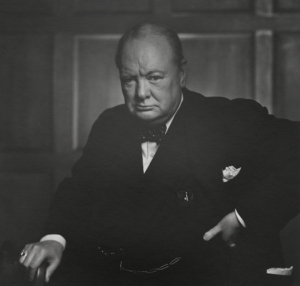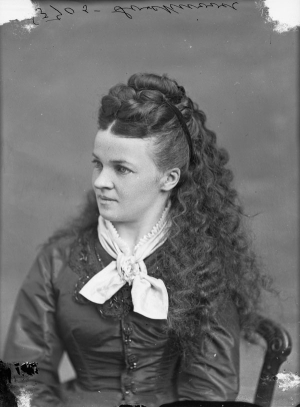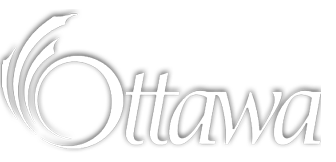Paul Couvrette and the Karsh Brothers
A record crowd of 130 came to hear Paul Couvrette’s Historical Society of Ottawa presentation on the Karsh brothers which was held at the Main Branch of the Ottawa Public Library on the afternoon of April 27, 2024. Paul, a celebrated Ottawa photographer, was both a professional colleague and family friend of the two Karsh brothers. Paul also has the distinction of having photographed all the Prime Ministers from Trudeau to Trudeau, and of being called upon to give photography lessons to Her Majesty, Queen Elizabeth II, so she could take better pictures of her Corgis.
Yousuf (1908-2002) and Malak (1915-2001) Karsh, with their parents and brother Jamil, fled the Armenian genocide making their way to Aleppo , Syria in 1922. Late in 1923, Yousuf sailed from Beirut to join his uncle George, a photographer, in Sherbrooke , Quebec. Yousuf had little formal education or knowledge of either French or English, but learnt photography from his uncle before apprenticing in Boston between 1928 and 1931. He then moved to Ottawa and worked for John Powis before opening his own studio in 1932.
Paul showed us a number of photos, some by Yousuf, some by Malak and some of his own. He used these to relate stories, sometimes about the photo itself, sometimes about the technique used, and sometimes focussing on a personal memory or incident. He mentioned that like all photographers starting out, Yousuf did passport photos, shot weddings, did commercial and industrial work, and essentially took on whatever work was available at the time. Yousuf was a member of the Ottawa Little Theatre and did many photos for them. Paul explained that this was where Yousuf developed his lighting style that would later become his trademark in his portrait photographs.
Paul showed us the portrait photo known as “The Roaring Lion”. This is the December 30, 1941 photo of then British Prime Minister Sir Winston Churchill. Paul noted that the shoot, which only lasted a few minutes, was arranged by then Canadian Prime Minister Mackenzie King, who was a great supporter of Yousuf Karsh. Paul went on to discuss that story that just prior to the taking of the portrait, Karsh had taken the cigar away from Churchill. He said that he didn’t know if the story is true, but that if it is, it was something that Karsh had likely planned to do, as he researched and spoke with his subjects. This is a technique that Paul learnt from Yousuf and now employs himself. Although it is the best known portrait of Churchill, and is used on the British £5 note, it is not liked by the family. The family remembers Winston as a jovial man, not the scowling bulldog captured by Karsh that day. The photo changed the career and the life of Yousuf Karsh. The Karsh portrait became the “gold standard” and he was now sought out by all persons of importance, and those who believed themselves to be.
Paul then related a humourous side bar to the aforementioned photo. After the theft of a signed print of the photo from the reading room of the Chateau Laurier hotel was announced in August 2022, the Bytown Museum announced, the following April 1st, the anonymous donation to their collection of a similar item. It was a great way for a small museum to garner some press.
Humour is something the public does not associate with Yousuf Karsh, but Paul maintains that he was a very funny man and recounted a couple of stories to illustrate this. On one occasion, Paul encountered Yousuf outside the Chateau Laurier, where he was then living. It was a terrible winter’s day, cold and with driving snow. Paul asked him why he had left the Middle East to come to Canada. Yousuf turned to Paul and replied “the weather”. On another occasion, Paul was talking with Yousuf about a recent portrait the latter had taken. Paul asked if Yousuf had noticed that there was a fly on the back of the chair behind the subject. Yousuf responded that the hardest part of that portrait was to train the fly to sit there while the photo was being taken.
As the fame, demands, and costs of Yousuf Karsh increased, he became unable to meet all the demands that were placed upon him. Paul noted that he was one of the beneficiaries of the referrals that Yousuf was forced to make, one client, a Supreme Court Justice, jokingly referring to Paul as “the poor man’s Karsh”.
In 1937, Malak joined his Uncle George and brother Yousuf in Canada and studied photography with them. Paul told us that although Malak is primarily known for his landscape work, he also did portrait, commercial, and industrial work and showed us examples of each. Malak is, however, best known for his images of Parliament Hill and of tulips. Malak was instrumental in the founding of the Tulip Festival in 1953.
Paul recounted an incident in which he encountered Malak taking a photo of some tulips. Paul remembers that Malak set up and waited for an hour to get exactly the right shot he wanted. Paul explained that in the age of film photography, you took one or perhaps two pictures, unlike the digital age of today when you can take as many pictures as you like and discard the many that are not worth keeping.
Perhaps Malak’s best known photo, (for those of a certain age), was entitled Paper and Politics, It was an unplanned photo taken in 1963 while he was working on a contract for E. B. Eddy and shows a number of logs and logging boats in the Ottawa River below Parliament Hill. The photo served as the inspiration for the engraving on the back of Canada’s last $1 bill. The fascinating story can be read at: Mishap on the dollar .
In 2017 to mark the 150 th anniversary of Confederation and the 25 th anniversary of the establishment of diplomatic relations between Armenia and Canada, the Armenian people donated a bust of Yousuf Karsh to the people of Canada. The bust stands outside the Chateau Laurier at the corner of Rideau Street and Mackenzie Avenue. You can read more on this at: Yousuf Karsh Bust .
Currently, there is no similar monument honouring the career and contributions of Malak Karsh. There is, however, work underway to redress this inequity. You can read the proposal at: Malak Karsh Monument Proposal, and you can get involved or provide your support by contacting Michel Gauthier at: This email address is being protected from spambots. You need JavaScript enabled to view it. .
Paul Lauzon has recorded the presentation, available via the following link: https://historicallyspeakingottawa.blogspot.com/2024/04/take-one-paul-couvrette-friend-and.html
Alvira Lockwood: Ottawa’s First Female Photographer
Born in Kemptville, Ontario (Canada West) on October 6, 1842 to Elizabeth “Melinda” Pierce and Joseph Lockwood, Alvira Lockwood, the eldest of eight children, was one of Ottawa’s earliest photographers, as well as the city’s first professional female photographer, and likely, its youngest. Her vast catalogue has been all but lost over the years – her negatives destroyed by fire or discarded, her photographs rare and mostly in private holdings, and her pioneering work largely unknown outside of local photographic circles. However, her impact on the development of photography, and of the art scene in general in Ottawa was undeniable.
From a young age, Alvira began her informal education in the photographic process by assisting her father Joseph, a traveling daguerreotype artist originally from Madrid, New York. Throughout the 1840s, Joseph operated via a horse-drawn portable photography saloon in Carleton and Lanark Counties, as well as in upper New York State and western Quebec with partner George Martin of Montréal.[[1]] In 1851, after several itinerant years, the Lockwood family settled in Bytown and built a home and studio on Sparks Street. Joseph’s studio, Lockwood’s Daguerrean Gallery, advertised daguerreotypes, melainotypes, and ambrotypes, and dealt in photographic supplies.[[2]] The home was said to have been quite conspicuous, being the first building at the western end of Sappers Bridge.[[3]] Unfortunately, by early 1859 the landowner, Sir Henry Egan, notified Joseph of his intention to reclaim the land and the home was pulled down. Lockwood Studio then moved into a space over Scott’s Confectionary on the southwest corner of Sparks and Elgin Streets.[[4]]
Sadly, Joseph Lockwood died of consumption in 1859, and ownership of the business passed to Melinda. Alvira, who was just 12 years old at the time of her father’s death, was ever-present in the studio and knew the business and the photographic process well. She later stated, “from the time I was seven years old I had always been around the studio” and, “at fifteen I was a full-fledged photographer.”[[5]]
 Figure 2 Notman Studios, William James Topley (attrib.), Sparks Street Storefront (detail), c.1870, City of Ottawa Archives, MG597.
Figure 2 Notman Studios, William James Topley (attrib.), Sparks Street Storefront (detail), c.1870, City of Ottawa Archives, MG597.
By 1863 Alvira began operating the studio under her own name. Her studio at 15 Sparks Street (renumbered 44 Sparks Street after 1875) was adorned with a simple sign that read “A. Lockwood,” with a larger sign featuring an image of an old daguerreotype camera (a nod to her father’s earlier work) and reading “Photographic Rooms” at the building’s gable.[[6]] Alvira’s photographic work focused almost exclusively on portraiture. By the later part of the 1860s she was producing mostly carte-de-visite prints and cabinet cards, which were more accessible to the burgeoning middle class than earlier cased photographs.
In 1870, Alvira had built a house on Rideau Street (between Nelson and Friel Streets), where she lived with her mother, and where she also maintained both an office of sorts and her amateur painting studio.[[7]] On March 19, 1872, the home was destroyed by fire. In the aftermath, the Ottawa Journal reported that many citizens had “joined in making up a purse… as a tribute of their regard… to a most deserving lady on the occasion of [Alvira’s] recent trouble.”[[8]] Following the fire, Alvira continued her work in Ottawa, operating on Sparks Street while living in the up-and-coming Sandy Hill neighbourhood.[[9]]
Alvira closed her studio in 1883 to pursue an education in painting, a long-enduring passion which she had set aside in order to focus on the family business. She first relocated to New York, and then to Paris, where, according to a later interview in the Ottawa Citizen, she spent a further five years “under the great teachers of the eighties.”[[10]] Alvira returned to Ottawa in 1891 and opened a new studio in her home at 386 Rideau Street where she devoted considerable time to painting. For many years Alvira “taught oil painting, painting on china, charcoal work, burnt wood work, water colors, etc.” out of her home studio, which was judiciously hung with her own works.[[11]] She entered, and often won, competitions at local fairs, submitting works of embroidery, painting, charcoal, and more.[[12]] Later in life, Alvira continued her artistic endeavours, taking woodworking classes and remaining active within the community. She was a member of the Ottawa Horticultural Society and the Canadian Red Cross. An article in the Ottawa Citizen described an eighty-year-old Alvira as “not a bit” old fashioned: “She lives vigerously [sic] in the present and is right up to date.[[13]]
Alvira Lockwood died at the Perley Home for Incurables on April 5, 1925, at the age of 82. She had been suffering from hemiplegia (paralysis) for several months, eventually dying of heart failure. Her funeral was attended by her brother Joseph, as well as her sister Eliza Lockwood, Mrs. B. Billings, and Mrs. Jennie Russell Simpson, then-member of the Women’s Canadian Historical Society of Ottawa, among many others.[[14]] A handful of her portraits remain in museums and private collections, while an unsubstantiated portrait of the artist herself exists within the holdings of Library and Archives Canada. The Bytown Museum currently holds a collection of fifteen of her portraits. Alvira was pioneer in Ottawa’s burgeoning photography scene, Ottawa’s first professional female photographer and a beloved figure in the city’s artistic community.
Grant Vogl is the Senior Manager, Collections and Exhibitions, at the Bytown Museum. Grant has worked in the heritage sector since 2007, holding various positions relating to: collections management, curatorial research, and exhibition development. With the Bytown Museum since 2010, Grant has curated sixteen temporary exhibitions, co-curated twenty-two community-based exhibitions, and undertaken major updates throughout the Museum's permanent gallery. In addition, he has led the Museum's digital initiatives, including social media, virtual tours, video guided tour and vignette series, digitization, and more. Grant has contributed to numerous periodicals, publications, books, conferences, research papers, and partner exhibitions, and delivers regular public lectures throughout the heritage community. In 2022 Grant spearheaded the OMA award-winning "Permanent Gallery Renewal Project" in close collaboration in the Algonquin community, presenting the topic at the 2023 CMA conference.
Notes
[[1]] Curtis Gates, Our County and Its People: A Memorial Record of St. Lawrence County (New York: D. Mason, 1894), 88-89.
[[2]] Clint Hryhoijiw, “Clint’s Curio Corner,” Email Supplement to Photographic Canadiana for Volumes 10-12, January 2013, 7, https://phsc.ca/camera/wp-content/uploads/2013/01/PHSC-E-Mail-V12-10rev.pdf; Gates, Curtis, Our County and Its People, 88-89;“Along Sparks Street,” The Ottawa Citizen, November 9, 1907, 19, Newspapers.com.
[[4]] “View of the Southwest Corner of Sparks and Elgin Streets 55 Years Ago,” The Ottawa Citizen, June 20, 1925, 26, Newspapers.com.
[[6]] Notman Studios/William J. Topley, “Sparks Street storefront,” ca.1870s, City of Ottawa Archives, MG597.
[[7]] Cherrier & Kirwin's Ottawa Directory For1872-1873, (Ottawa: Cherrier & Kirwin 1872), 89,156, https://vitacollections.ca/ottawalibrary/3566634/page/3?n=.
[[8]] “Destructive Fire,” The Ottawa Daily Citizen, March 20, 1872, 3, Newspapers.com; “A Handsome Testimonial,” The Ottawa Daily Citizen, March 21, 1872, 3, Newspapers.com.







